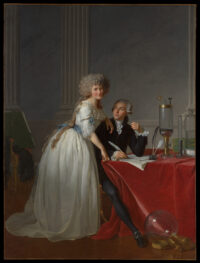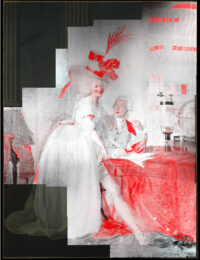A new study of a 1788 portrait of pioneering chemist Antoine Lavoisier, discoverer of oxygen, and his wife Marie Anne by Jacques-Louis David has revealed a full underpainting that depicted the couple as wealthy consumers of luxury goods, not the icons of science and progress presented in the finished work.
 At 8.5 feet wide and 6.4 feet high, the portrait is monumental in size, a format that for portraits had been the province solely of royal sitters. Antoine and Marie-Anne Lavoisier are depicted in fashionable, but simple, attire — him in the habit noir reserved for men in the professions, her in a chemise a la reine, a white muslin gown with a colorful sash popularized by Marie Antoinette in the 1780s during her Petit Trianon I’m-just-a-simple-shepherdess roleplay phase. Madame Lavoisier is standing, Lavoisier seated but with his well-turned leg extended under the table. A jumble of scientific instruments crowd the table and floor. This was the portraiture tradition of the late Ancient Régime reconfigured for the Age of Revolution, celebrating Enlightenment ideals over divine right, science and invention over noble lineage.
At 8.5 feet wide and 6.4 feet high, the portrait is monumental in size, a format that for portraits had been the province solely of royal sitters. Antoine and Marie-Anne Lavoisier are depicted in fashionable, but simple, attire — him in the habit noir reserved for men in the professions, her in a chemise a la reine, a white muslin gown with a colorful sash popularized by Marie Antoinette in the 1780s during her Petit Trianon I’m-just-a-simple-shepherdess roleplay phase. Madame Lavoisier is standing, Lavoisier seated but with his well-turned leg extended under the table. A jumble of scientific instruments crowd the table and floor. This was the portraiture tradition of the late Ancient Régime reconfigured for the Age of Revolution, celebrating Enlightenment ideals over divine right, science and invention over noble lineage.
The oil-on-canvas painting, now in the collection of the Metropolitan Museum of Art, was studied with infrared reflectography (IRR), macro X-ray fluorescence (MA-XRF) mapping, microanalysis of paint samples and optical microscopy. This is the first imaging and chemical analysis of the portrait since it was painted, and the first published technical study of any Jacques-Louis David. IRR spotted some shadowy shapes under the current portrait layer, but it was MA-XRF that revealed there was a previous version of the painting underneath, a version that completely upends the standard interpretation of this landmark work.
 Instead of the sober neoclassical grey walls in the background, the original portrait featured floor-to-ceiling bookshelves filled with matching volumes. Lavoisier’s habit noir is draped with a red mantle. His desk is richly decorated with an ormulu relief and scrolls of paper spread over the top instead of the laboratory equipment. Madame Lavoisier is wearing an obnoxiously large hat wrapped in ribbons and artificial flowers with a giant plume sprouting from the top of it.
Instead of the sober neoclassical grey walls in the background, the original portrait featured floor-to-ceiling bookshelves filled with matching volumes. Lavoisier’s habit noir is draped with a red mantle. His desk is richly decorated with an ormulu relief and scrolls of paper spread over the top instead of the laboratory equipment. Madame Lavoisier is wearing an obnoxiously large hat wrapped in ribbons and artificial flowers with a giant plume sprouting from the top of it.
This is a scene of an affluent couple aspiring to the trappings and standing of the societal elite. It is Lavoisier the tax collector, the day job that financed his experiments and that would ultimately condemn him to the guillotine in 1794. It’s likely that the rapidly shifting political situation in France played a part in this radical change to the portrait, but it may also have been a stylistic choice, a key transition in portraiture from the late Ancien Régime roccoco to the neoclassical style that David had already presented to enormous acclaim in historical subjects like the Oath of the Horatii (1784).
David’s skills were made evident not only in how he built these and other paint passages, but also in how he concealed fully painted features in the early composition leaving so few clues behind by carefully choosing the components of the paint mixtures to ensure full coverage with thin applications. […]
David’s portrait of Antoine Lavoisier and his wife Marie-Anne Pierrette Paulze is a work that responded to the quickly changing historical circumstance in which the artist and his sitters found themselves on the brink of the French Revolution. Although Madame Lavoisier survived the reign of terror, Lavoisier’s genius did not save him from the guillotine in 1794, only 6 years after the completion of the portrait. Beyond deepening our understanding of the Lavoisiers’ shifting social identity, these findings also reframe an artist as he embraced and helped formulate French neoclassicism.